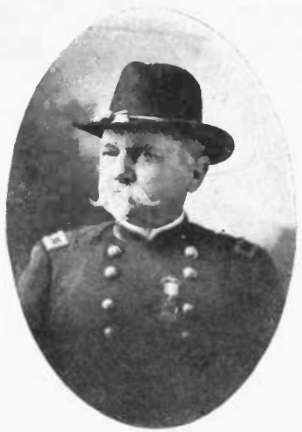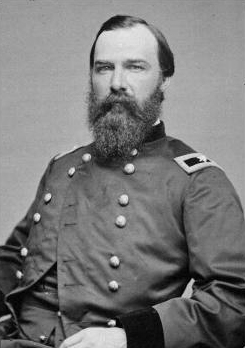<Back to Index>
- Colonel of the U.S. Army John Green, 1825
- Major General of the U.S. Army Alvan Cullem Gillem, 1830
PAGE SPONSOR

John Green (November 20, 1825 – November 22, 1908) was a United States cavalry officer, who was awarded a Medal of Honor for his bravery and leadership at the First Battle of the Stronghold during the Modoc War.
Green, of German birth, came to the U.S. at age 6 in 1831. He grew up to become apprenticed to a carpenter on one occasion and to a cabinetmaker, but he did not feel his life was in those lines of work and instead enlisted in the army aged 21.
Green entered the army in 1846, he fought in the Mexican - American War under General Winfield Scott as a Sergeant. He later served as an officer in the American Civil War and rose through the ranks to become Colonel.
At the First Battle of the Stronghold during the Modoc War Green's men displayed a reluctance to fight Modoc warriors, who had been inflicting casualties on their unit. Green left cover, and, standing in full view of the Modoc warriors, proceeded to pace in front of his men, slapping his gloves in his palm for emphasis. Although exposed to enemy fire, Green survived, although he was injured, and remained in command.
Rank and Organization: Major, 1st U.S. Cavalry. Place and Date: At the Lava Beds, Calif., January 17, 1873. Entered Service At: Ohio. Birth: Germany. Date of Issue: November 18, 1897.
In order to reassure his command, this officer, in the most fearless manner and exposed to very great danger, walked in front of the line; the command, thus encouraged, advanced over the lava upon the Indians who were concealed among the rocks.

Alvan Cullem Gillem (July 29, 1830 – December 2, 1875) was a general in the Union Army during the American Civil War. Although Southern born, he remained loyal to the Federal government and fought in several battles in the Western Theater before commanding occupation troops in Mississippi and Arkansas during Reconstruction. He later played a prominent role in the Modoc War in 1873.
Gillem was born in Gainesboro in Jackson County, Tennessee, the son of Samuel Gillem. In 1851, he graduated 11th in his class from the United States Military Academy and was assigned as a second lieutenant to the artillery. He was soon sent to the front lines in Florida to serve in a battery during the Second Seminole War until 1852. He was then reassigned to the Texas frontier following the war.
With the outbreak of the Civil War, Gillem became a captain on May 14, 1861, initially serving under George H. Thomas. Gillem was chief quartermaster of the Army of the Ohio in the several Tennessee campaigns and was brevetted as a major for gallantry in the Battle of Mill Springs. He was appointed colonel of the 10th Tennessee Infantry in May 1862 and served for a time as the provost marshal of Nashville during the Federal occupation of the city.
From June 1, 1863, until the close of the war, with rank of brigadier general of volunteers, he was active in Tennessee, where he was adjutant general. He commanded the troops guarding the Nashville and Northwestern railroad from June 1863, until August 1864. In a campaign to protect the loyal mountaineers in eastern Tennessee, his troops surprised and killed Confederate General John H. Morgan in Greeneville, on September 4, 1864. Operating later in the year near Marion, Virginia, Gillem performed well in combat against the Confederates and was again recognized for bravery, being brevetted as a colonel in the Regular Army.
Gillem was vice president of the convention (January 9, 1865) for the revision of the constitution of the State of Tennessee, and sat in the first Legislature elected thereafter. Afterwards, Gillem commanded the Union cavalry in east Tennessee, and participated in an expedition to North Carolina which resulted in the capture of Salisbury. For this action, he was brevetted as a major general in the volunteer army, his third such citation of the war.
Following the war, in January 1866, Gillem was assigned command of the Fourth Military District, headquartered in Vicksburg, Mississippi, and composed of the Federal occupation forces in Mississippi and Arkansas. He was mustered out of the volunteer army and commissioned as a colonel in the Regular Army on July 28, 1866. Gillem supervised the district until 1868. He often feuded with the Radical Republicans in the United States Congress over his lenient treatment of ex Confederate soldiers in his district.
When Ulysses S. Grant assumed the Presidency in 1869, Gillem was removed from the Fourth Military District in favor of Grant's personal friend Edward Ord. He was reassigned to duty in Texas, and later to California, where he was prominent in the military operations against the Modoc Indians in 1873. He was engaged in the attack at the Lava Beds on April 15, 1873. However, some of his troops were surprised and thoroughly beaten on April 26 at the Battle of Sand Butte, losing over 40% of their strength. Following the so-called "Thomas - Wright Massacre," many called for Colonel Gillem to be removed. On May 2, the new commander of the Department of the Columbia, Brig. Gen. Jefferson C. Davis formally relieved Gillem of command, and personally assumed control of the army in the field.
In 1875, Gillem became seriously ill and returned home to Tennessee to recuperate. However, he died in the Soldier's Rest home near Nashville at the relatively young age of 45. He was buried in the city's Mount Olivet Cemetery.